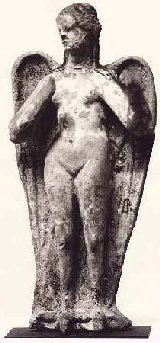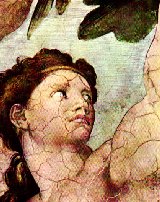| The Lilith Myth
|
   |
|
Authors’ Comments on the Myth: 1. The tradition that man's first sexual intercourse was with animals, not women, may be due to the widely spread practice of bestiality among herdsmen of the Middle East, which is still condoned by custom, although figuring three times in the Pentateuch as a capital crime. In the Akkadian Gilgamesh Epic, Enkidu is said to have lived with gazelles and jostled other wild beasts at the watering place, until civilized by Aruru's priestess. Having enjoyed her embraces for six days and seven nights, he wished to rejoin the wild beasts but, to his surprise, they fled from him. Enkidu then knew that he had gained understanding, and the priestess said: 'Thou art wise, Enkidu, like unto a godl' 2. Primeval man was held by the Babylonians to have been androgynous. Thus the Gilgamesh Epic gives Enkidu androgynous features: `the hair of his head like a woman's, with locks that sprout like those of Nisaba, the Grain-goddess.' The Hebrew tradition evidently derives from Greek sources, because both terms used in a Tannaitic midrash to describe the bisexual Adam are Greek: androgynos, 'man-woman', and diprosopon, 'twofaced'. Philo of Alexandria, the Hellenistic philosopher and commentator on the Bible, contemporary with Jesus, held that man was at first bisexual; so did the Gnostics. This belief is clearly borrowed from Plato. Yet the myth of two bodies placed back to back may well have been founded on observation of Siamese twins, which are sometimes joined in this awkward manner. The two-faced Adam appears to be a fancy derived from coins or statues of Janus, the Roman New Year god. 3. Divergences between the Creation myths of Genesis r and n, which allow Lilith to be presumed as Adam's first mate, result from a careless weaving together of an early Judaean and a late priestly tradition. The older version contains the rib incident. Lilith typifies the Anath-worshipping Canaanite women, who were permitted pre-nuptial promiscuity. Time after time the prophets denounced Israelite women for following Canaanite practices; at first, apparently, with the priests' approval-since their habit of dedicating to God the fees thus earned is expressly forbidden in Deuteronomy xxIII. I8. Lilith's flight to the Red Sea recalls the ancient Hebrew view that water attracts demons. 'Tortured and rebellious demons' also found safe harbourage in Egypt. Thus Asmodeus, who had strangled Sarah's first six husbands, fled 'to the uttermost parts of Egypt' (Tobit viii. 3), when Tobias burned the heart and liver of a fish on their wedding night. 4. Lilith's bargain with the angels has its ritual counterpart in an apotropaic rite once performed in many Jewish communities. To protect the newborn child against Lilith-and especially a male, until he could be permanently safeguarded by circumcision-a ring was drawn with natron, or charcoal, on the wall of the birthroom, and inside it were written the words: 'Adam and Eve. Out, Lilith!' Also the names Senoy, Sansenoy and Semangelof (meanings uncertain) were inscribed on the door. If Lilith nevertheless succeeded in approaching the child and fondling him, he would laugh in his sleep. To avert danger, it was held wise to strike the sleeping child's lips with one finger-whereupon Lilith would vanish. 5. 'Lilith' is usually derived from the Babylonian-Assyrian word lilitu, ,a female demon, or wind-spirit'-one of a triad mentioned in Babylonian spells. But she appears earlier as 'Lillake' on a 2000 B.G. Sumerian tablet from Ur containing the tale of Gilgamesh and the Willow Tree. There she is a demoness dwelling in the trunk of a willow-tree tended by the Goddess Inanna (Anath) on the banks of the Euphrates. Popular Hebrew etymology seems to have derived 'Lilith' from layil, 'night'; and she therefore often appears as a hairy night-monster, as she also does in Arabian folklore. Solomon suspected the Queen of Sheba of being Lilith, because she had hairy legs. His judgement on the two harlots is recorded in I Kings III. 16 ff. According to Isaiah xxxiv. I4-I5, Lilith dwells among the desolate ruins in the Edomite Desert where satyrs (se'ir), reems, pelicans, owls, jackals, ostriches, arrow-snakes and kites keep her company. 6. Lilith's children are called lilim. In the Targum Yerushalmi, the priestly blessing of Numbers vi. 26 becomes: 'The Lord bless thee in all thy doings, and preserve thee from the Lilim!' The fourth-century A.D. commentator Hieronymus identified Lilith with the Greek Lamia, a Libyan queen deserted by Zeus, whom his wife Hera robbed of her children. She took revenge by robbing other women of theirs. 7. The Lamiae, who seduced sleeping men, sucked their blood and ate their flesh, as Lilith and her fellow-demonesses did, were also known as Empusae, 'forcers-in'; or Mormolyceia, 'frightening wolves'; and described as 'Children of Hecate'. A Hellenistic relief shows a naked Lamia straddling a traveller asleep on his back. It is characteristic of civilizations where women are treated as chattels that they must adopt the recumbent posture during intercourse, which Lilith refused. That Greek witches who worshipped Hecate favoured the superior posture, we know from Apuleius; and it occurs in early Sumerian representations of the sexual act, though not in the Hittite. Malinowski writes that Melanesian girls ridicule what they call `the missionary position', which demands that they should lie passive and recumbent. 8. Naamah, 'pleasant', is explained as meaning that 'the demoness sang pleasant songs to idols'. Zmargad suggest smaragdos, the semi-precious aquamarine; and may therefore be her submarine dwelling. A demon named Smaragos occurs in the Homeric Epigrams. 9. Eve's creation by God from Adam's rib-a myth establishing male supremacy and disguising Eve's divinity-lacks parallels in Mediterranean or early Middle-Eastern myth. The story perhaps derives iconotropically from an ancient relief, or painting, which showed the naked Goddess Anath poised in the air, watching her lover Mot murder his twin Aliyan; Mot (mistaken by the mythographer for Yahweh) was driving a curved dagger under Aliyan's fifth rib, not removing a sixth one. The familiar story is helped by a hidden pun on tsela, the Hebrew for 'rib': Eve, though designed to be Adam's helpmeet, proved to be a tsela, a 'stumbling', or 'misfortune'. Eve's formation from Adam's tail is an even more damaging myth; perhaps suggested by the birth of a child with a vestigial tail instead of a coccyx-a not infrequent occurrence. 10. The story of Lilith's escape to the East and of Adam's subsequent marriage to Eve may, however, record an early historical incident: nomad herdsmen, admitted into Lilith's Canaanite queendom as guests (see 16. 1), suddenly seize power and, when the royal household thereupon flees, occupy a second queendom which owes allegiance to the Hittite Goddess Heba. The meaning of 'Eve' is disputed. Hawwah is explained in Genesis III. 20 as 'mother of all living'; but this may well be a Hebraicized form of the divine name Heba, Hebat, Khebat or Khiba. This goddess, wife of the Hittite Storm-god, is shown riding a lion in a rock-sculpture at Hattusaswhich equates her with Anath-and appears as a form of Ishtar in Hurrian texts. She was worshipped at Jerusalem (see 27. 6). Her Greek name was Hebe, Heracles's goddess-wife. -- Hebrew Myths by Robert Graves
and Raphael Patai (New York: Doubleday, 1964), pp 65-69.
Click here to Buy the Book |
|

